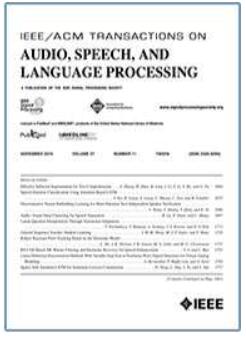用于主动噪声控制网络的滤波-X 准仿射投影算法
IF 5.1
2区 计算机科学
Q1 ACOUSTICS
IEEE/ACM Transactions on Audio, Speech, and Language Processing
Pub Date : 2024-09-12
DOI:10.1109/TASLP.2024.3458806
引用次数: 0
摘要
仿射投影(AP)算法可提高基于梯度的自适应算法在处理彩色参考信号时的性能,而滤波 X 型算法通常就是这种情况。这种增强是通过使用参考信号数据向量的各种延迟版本来实现的,这些延迟版本经过适当的正交化和归一化处理,以优化收敛性能。这些向量的数量,即 AP 的投影阶数,会增加计算需求,主要是因为需要计算矩阵反演,而矩阵反演的维数与投影阶数成正比。在分布式系统中使用时,AP 算法通常要求系统中的每个声学节点计算完整的矩阵反演,即使它们只需要其中的特定数据集(子块)。这意味着,在分布式协作网络中使用 AP 算法时,在节省计算量方面并没有太大优势。为了解决这个问题,本文引入了近似版本的过滤-X 仿射投影算法(FXAP)。该近似版本使用预先计算好的逆矩阵,避免了每次迭代中的矩阵反转计算。这一策略不仅节省了计算量,而且便于算法的推广。此外,还提出了一种步长可变的方法,以减轻预计算矩阵造成的偏差,从而提供良好的性能、高鲁棒性和经济高效的分布。本文章由计算机程序翻译,如有差异,请以英文原文为准。
Filtered-X Quasi Affine Projection Algorithm for Active Noise Control Networks
The affine projection (AP) algorithm enhances the performance of gradient-based adaptive algorithms when dealing with colored reference signals, which is typically the case with filtered-X type algorithms. This enhancement is achieved by using various delayed versions of the reference signal data vector, which are appropriately orthogonalized and normalized to optimize convergence performance. The number of these vectors, known as the projection order of the AP, increases the computational requirements, mainly due to the calculation of a matrix inversion whose dimensions are proportional to this projection order. When used in distributed systems, the AP algorithm typically requires each acoustic node in the system to compute the complete matrix inversion, even though they only need a specific set of data (a subblock) from it. This means that the AP does not offer much advantage in terms of computational savings when used in distributed collaborative networks. To address this issue, an approximate version of the filtered-X affine projection (FXAP) algorithm is introduced in this work. This approximate version avoids the matrix inversion computation in each iteration using a precalculated inverse matrix. This strategy provides computational savings and enables easy distribution of the algorithm. Additionally, a variable step-size approach is proposed to mitigate the deviation caused by a precalculated matrix, which provides good performance, high robustness, and cost-effective distribution.
求助全文
通过发布文献求助,成功后即可免费获取论文全文。
去求助
来源期刊

IEEE/ACM Transactions on Audio, Speech, and Language Processing
ACOUSTICS-ENGINEERING, ELECTRICAL & ELECTRONIC
CiteScore
11.30
自引率
11.10%
发文量
217
期刊介绍:
The IEEE/ACM Transactions on Audio, Speech, and Language Processing covers audio, speech and language processing and the sciences that support them. In audio processing: transducers, room acoustics, active sound control, human audition, analysis/synthesis/coding of music, and consumer audio. In speech processing: areas such as speech analysis, synthesis, coding, speech and speaker recognition, speech production and perception, and speech enhancement. In language processing: speech and text analysis, understanding, generation, dialog management, translation, summarization, question answering and document indexing and retrieval, as well as general language modeling.
 求助内容:
求助内容: 应助结果提醒方式:
应助结果提醒方式:


